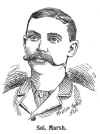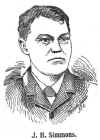Otsego county, New York, Sept. 7, 1852. His mother died when he was young; he then lived with his grandparents until he was in his twentieth year, when he came
 to Norton county, an account of which was given in a previous chapter.
He was elected County clerk in September, 1872, served as county commissioner by appointment during 1873, was appointed sheriff to fill vacancy caused by the resignation of John Bieber in 1874, and was constable of Center township for several years. to Norton county, an account of which was given in a previous chapter.
He was elected County clerk in September, 1872, served as county commissioner by appointment during 1873, was appointed sheriff to fill vacancy caused by the resignation of John Bieber in 1874, and was constable of Center township for several years.
Sol and Sarah Marsh have had seven children, four of them still living. Their eldest, Linnie G., was born Nov. 9, 1874, died April 6, 1877; Fred R., born Feb. 22, 1878; James Harvey, Nov. 15, 1880; Franklin, July 30, 1883, died June 25, 1884; Edwin C., born Aug. 14, 1885, was drowned in the Prairie Dog by accidentally falling from a foot log May 28, 1888; Eleanor B was born April
5, 1888. Their youngest child was born Dec. 24, 1893. He has one of the finest
equipped farms and stock ranches in Norton county, which joins the city on the east; be feels cattle and hogs on a
large scale and is one of our most public spirited citizens. During the county seat contest he was an active Norton man and was always considered one of the leaders in behalf of this city during the troubles.
 Grace Ella Curry married Joel E. Simmons, who was born in McDonongh county, Illinois, April 20, 1847.
After obtaining a common school education he graduated from the McComb High School.
Being of a studious turn of mind he at once adopted the vocation of teacher and at the same time continued his studies.
He came to eastern Kansas in 1871, and to Norton county in 1872, as previously described.
He taught the first school in this county, which he describes as follows in the Norton County Advance, in 1878:
Grace Ella Curry married Joel E. Simmons, who was born in McDonongh county, Illinois, April 20, 1847.
After obtaining a common school education he graduated from the McComb High School.
Being of a studious turn of mind he at once adopted the vocation of teacher and at the same time continued his studies.
He came to eastern Kansas in 1871, and to Norton county in 1872, as previously described.
He taught the first school in this county, which he describes as follows in the Norton County Advance, in 1878:
"On the first day of December 1873 the writer commenced teaching the first school ever taught in the county, the school was taught in a small dugout in Norton, there were sixteen pupils in attendance. and the time was by no means
wasted. It was a subscription school and like most others of the kind, much of the pay promised is still unpaid, but the teacher pursuaded
(sic) one of the pupils to become his wife so that be considered himself gainer even in that
speculation."
He was elected county clerk in November 1873, but after the crop failure in 1874 he went to Brown county to teach, leaving his office in charge of John R. Hamilton as deputy.
When the aid bonds had been issued, a fact that will be referred to later on, the commissioners took the position that these bonds must be signed by the county clerk instead of by a deputy; so on January 4, 1875, they declared the office of county clerk vacant, and appointed M. J. Fitz Patrick to fill the vacancy.
The real reason for the removal of Simmons was not on account of the bonds, but the county seat fight between Norton and Leota was at that time being agitated.
The commissioners were Leota men and desired a county clerk who was in sympathy with them.
In the summer of 1875 Simmons returned to his farm near Norton; at the November election he was the Norton candidate for the legislature, but was defeated by Dr. Green.
He taught the Norton school that winter and was elected superintendent two terms, 1876 and 1878; he was again elected in 1886 also in 1888 but went down along with the balance of the republican ticket - in 1890.
He taught the Neighborville school in 1876, was for several years editor of the Norton Courier.
He is an able writer; he wrote many poems of merit, in fact everything that comes from his pen is highly prized and eagerly read by everybody.
But he appears at his best in educational work. The educational
|